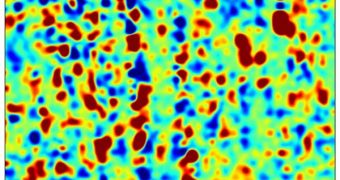A team of astronomers announces the completion of the most impressive, complete and thorough three-dimensional map of the distant Cosmos ever created. The new dataset was created using an unusual technique, and does not feature galaxies.
Rather than looking at starlight coming from these large-scale structures, the scientists who conducted the new work analyzed clouds of intergalactic hydrogen gas. This approach led to the creation of a high-resolution map, that will provide experts with a new way of analyzing the early Cosmos.
In order to complete this map, investigators used the light emitted by the brightest objects observable in the night sky. The oldest light to be detected by this survey was produced some 11 billion years ago, when the Universe was only 2.75 billion years old.
“Here, we are looking at intergalactic hydrogen gas, which blocks light. It's like looking at the moon through clouds – you can see the shapes of the clouds by the moonlight that they block,” explains researcher Anže Slosar, quoted by Space.
According to the expert, who holds an appointment as a physicist at the US Department of Energy's (DOE) Brookhaven National Laboratory (BNL), experts used the capabilities of the Sloan Digital Sky Survey (SDSS) to investigation the Lyman-alpha forest.
This is an irregular pattern of light that is created by the bright cores of distant, active galaxies. These galactic centers harbor supermassive black holes that emit radiation in all portions of the electromagnetic spectrum.
The Lyman-alpha forest pattern appears as light coming in from these distant quasars illuminated clouds of intergalactic hydrogen gas from behind. As these happens, the photons have their wavelengths shifted by various amounts, and this change can be used to assess distances.
“The most exciting thing for me personally is proving wrong everyone who was telling us that it is never going to work,” Slosar explains of using the effect to create 3D maps of the Universe. This was never demonstrated before, and may thought it was impossible.
This was “a large investment of time, 20 percent of a big international project, and it sort of had to work. But we were the first to show that it actually works,” he goes on to say.
“So, while we haven't yet discovered anything amazing about the universe itself using this technique, we demonstrated that it does work and that we will very likely discover new things,” the expert concludes.
Details of the new map, and the approach used to create it, were presented yesterday, May 1, at the American Physical Society (APS) meeting, held in Anaheim, California.

 14 DAY TRIAL //
14 DAY TRIAL //